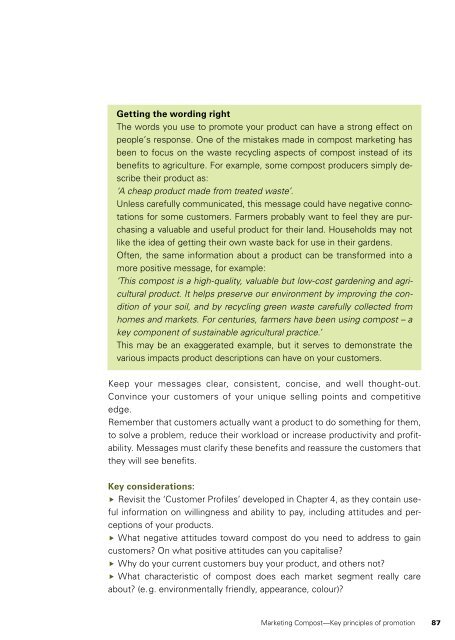Marketing Compost (EAWAG) - The Water, Sanitation and Hygiene
Marketing Compost (EAWAG) - The Water, Sanitation and Hygiene
Marketing Compost (EAWAG) - The Water, Sanitation and Hygiene
Create successful ePaper yourself
Turn your PDF publications into a flip-book with our unique Google optimized e-Paper software.
Getting the wording right<br />
<strong>The</strong> words you use to promote your product can have a strong effect on<br />
people’s response. One of the mistakes made in compost marketing has<br />
been to focus on the waste recycling aspects of compost instead of its<br />
benefits to agriculture. For example, some compost producers simply describe<br />
their product as:<br />
‘A cheap product made from treated waste’.<br />
Unless carefully communicated, this message could have negative connotations<br />
for some customers. Farmers probably want to feel they are purchasing<br />
a valuable <strong>and</strong> useful product for their l<strong>and</strong>. Households may not<br />
like the idea of getting their own waste back for use in their gardens.<br />
Often, the same information about a product can be transformed into a<br />
more positive message, for example:<br />
‘This compost is a high-quality, valuable but low-cost gardening <strong>and</strong> agricultural<br />
product. It helps preserve our environment by improving the condition<br />
of your soil, <strong>and</strong> by recycling green waste carefully collected from<br />
homes <strong>and</strong> markets. For centuries, farmers have been using compost – a<br />
key component of sustainable agricultural practice.’<br />
This may be an exaggerated example, but it serves to demonstrate the<br />
various impacts product descriptions can have on your customers.<br />
Keep your messages clear, consistent, concise, <strong>and</strong> well thought-out.<br />
Convince your customers of your unique selling points <strong>and</strong> competitive<br />
edge.<br />
Remember that customers actually want a product to do something for them,<br />
to solve a problem, reduce their workload or increase productivity <strong>and</strong> profitability.<br />
Messages must clarify these benefits <strong>and</strong> reassure the customers that<br />
they will see benefits.<br />
Key considerations:<br />
Revisit the ‘Customer Profiles’ developed in Chapter 4, as they contain useful<br />
information on willingness <strong>and</strong> ability to pay, including attitudes <strong>and</strong> perceptions<br />
of your products.<br />
What negative attitudes toward compost do you need to address to gain<br />
customers On what positive attitudes can you capitalise<br />
Why do your current customers buy your product, <strong>and</strong> others not<br />
What characteristic of compost does each market segment really care<br />
about (e. g. environmentally friendly, appearance, colour)<br />
<strong>Marketing</strong> <strong>Compost</strong>—Key principles of promotion 87

















